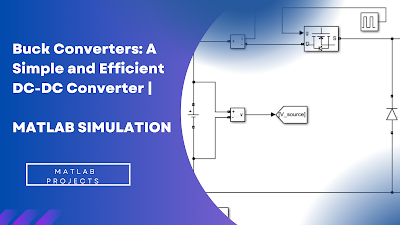 |
| Buck Converters: A Simple and Efficient DC-DC Converter |
Buck converters are a fundamental type of DC-DC converter used to step down a higher DC voltage to a lower DC voltage. They are widely used in various applications, including:
- Power supplies for electronic devices: Laptops, desktops, servers, and other electronic devices often use buck converters to regulate the voltage from their power adapters.
- Renewable energy systems: Buck converters are used in solar and wind power systems to efficiently convert the variable DC output of these sources to a stable DC voltage for use by inverters or batteries.
- Automotive applications: They are used in automotive electronics such as engine control units, power windows, and lighting systems.
How Buck Converters Work
The basic principle of a buck converter is relatively simple:
- Switching Phase: The main switch (typically a MOSFET) is turned on, connecting the input voltage (Vin) directly to the output.
- Freewheeling Phase: The main switch is turned off. The inductor's stored energy maintains current flow to the output through a diode.
By varying the duty cycle (the percentage of time the switch is on), the output voltage can be controlled. A higher duty cycle results in a higher output voltage.
MATLAB Simulation of a Buck Converter
To understand the behavior of a buck converter in more detail, simulating it using MATLAB can be very helpful.
 |
| Buck converter MATLAB circuit |
In this tutorial video, I demonstrate how to simulate a buck converter in MATLAB for different duty cycles: 70%, 50%, and 25%. The images below shows the different output waveform for each duty circle considered
 |
| Buck converter with a duty cycle of 70% |
 |
| Buck converter with a duty cycle of 50% |
 |
| Buck converter with a duty cycle of 25% |
The simulation results will show:
- Output voltage waveforms: How the output voltage changes with different duty cycles.
- Inductor current waveforms: The impact of duty cycle on inductor current and ripple.
- Efficiency analysis: How the efficiency of the converter varies with different duty cycles.
Key Takeaways:
- Buck converters are essential components in many electronic systems.
- They efficiently step down DC voltages.
- MATLAB simulations provide valuable insights into their behavior and performance.
I hope this blog post and the accompanying video provide a helpful overview of buck converters and their simulation in MATLAB.
Disclaimer: This blog post is for informational purposes only and does not constitute professional engineering advice. Always consult with qualified professionals for any specific design or application.
Additional Resources
- [Link to MATLAB's official documentation]
- [Link to our MATLAB Simulink tutorials]
- [Link to our video collection on MATLAB simulation]
Comments and Discussion
We encourage you to share your thoughts, questions, or experiences in the comments section of our social media handles. Feel free to ask for clarifications or share your own insights with the community.





